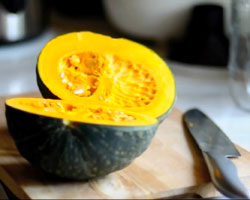For those who have outgrown the delight of a sugar rush, Halloween weekend may often feel like “candy, candy, everywhere and not a thing to eat.” The holiday’s ubiquitous carved jack o’ lanterns offer no reprieve, since they’re better used as decoration than pie filling.
“You definitely don’t want those jack o’ lantern type pumpkins [for cooking],” says Erica Wides, the host of the Heritage radio show “Let’s Get Real with Chefsmartypants." “They have no flavor, they’re watery, they’re stringy.” Instead, she suggests baking or cooking with less traditional looking pumpkins, such as Long Island cheese pumpkins, white Lumina pumpkins or Japanese kabochas. Wides points out that kabocha pumpkins (pictured below) have the advantage of ripening off the vine, and are often tastiest a week or two after being plucked from the field.
Horticulturalist Jessica Walliser goes so far as to recommend one of the ugliest pumpkins available: the pink, wart-covered Galeaux d’Esyines. There’s a good reason the gourd looks so ghastly. “These peanut looking warts on the outside are called corking,” says Walliser. “What happens is that the sugar content gets so high in this fruit that it actually fractures the skin and then they develop these warts. So, that tells you a little about what the flavor is going to be like because of this high sugar content.”
Both Wides and WNYC host Amy Eddings grew up with pumpkins in their backyard gardens (in Long Island and northern Ohio, respectively). Walliser says that for more space-restricted urbanites, black futsu pumpkins are smaller and have a compact vine that would make it feasible for smaller gardens. She adds that, several years ago, The New York Times dubbed the black futsu one of the best tasting pumpkins as well.
As for the pumpkin insides, regular orange pumpkin seeds tend to be tough and more trouble than they are worth, as Eddings discovered through trial and error. Wides, however, says that other pumpkins and winter squashes, such as Delicata squash, have seeds that roast well and make for a good snack. She doesn’t even mind letting some of the pumpkin goop roast along with the seeds, as it makes for something like pumpkin leather. As for the rest of the pumpkin, below is Wides’ recipe for "Vietnamese Braised Pumpkin."
Vietnamese Braised Pumpkin
by Erica Wides
Use a good eating pumpkin for this, like a Blue Hubbard, or a Kabocha. Both have a firm enough texture and dry flesh to withstand the braising without dissolving.
- 2 cups peeled and cubed pumpkin

- 2 cups peeled and cubed taro root or Yukon gold potato
- 10 dried shiitake mushrooms or wood ear mushrooms, soaked and sliced
- 1 can coconut milk
- 1 cup chicken stock, veg stock or water
- ½ cup roasted, unsalted peanuts
- 1 cup sliced zucchini
- fish sauce or salt
- 1 teaspoon palm sugar or light brown sugar
- handful of torn cilantro leaves
1. Place the pumpkin, taro, mushrooms, coconut milk, and stock in a deep saucepan and bring to a simmer. Cook gently until the pumpkin and taro are nearly done, about 15 minutes.
2. Add the peanuts and zucchini and simmer for 5 minutes, or until the zucchini is tender but not mushy.
3. Remove from the heat and add fish sauce or salt to taste and the sugar. Sprinkle with cilantro just before serving.